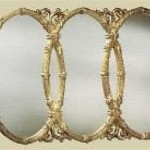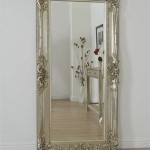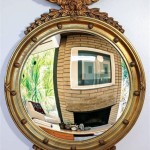Understanding Faux Antique Mirror Glass
Faux antique mirror glass, also known as aged mirror glass or distressed mirror glass, represents a modern technique to replicate the aesthetic qualities of authentic antique mirrors. These mirrors gain their unique appearance through years of natural aging processes, resulting in characteristic imperfections such as desilvering, spotting, and variations in tone. Faux antique mirror glass allows designers and homeowners to achieve a similar vintage look without needing to source and often pay a premium for genuine antique pieces. Moreover, it offers greater control over the degree and pattern of the aging effect.
The appeal of faux antique mirror glass lies in its ability to add character and warmth to a space. It evokes a sense of history and timelessness, making it a popular choice for a variety of interior design styles, from traditional and rustic to contemporary and eclectic. While authentic antique mirrors are undeniably beautiful, their fragility and scarcity can make them impractical for certain applications. Faux antique mirror glass provides a durable and readily available alternative, allowing for creative and versatile use in both residential and commercial settings.
Manufacturing faux antique mirror glass requires specific techniques that artificially induce the aging process. These methods aim to mimic the natural degradation that occurs over time in traditional mirrors. The process typically starts with a standard sheet of modern mirror glass, upon which specialized chemical treatments and layering techniques are applied to achieve the desired aged appearance.
Key Aspects of Faux Antique Mirror Glass Manufacturing
The production of faux antique mirror glass involves a carefully controlled process to create a convincing aged appearance. Several methods exist, each resulting in a distinct aesthetic. One common technique involves applying a diluted acid solution to the silvered surface of the mirror glass, selectively removing portions of the silver backing. This process creates the characteristic "desilvering" effect seen in genuine antique mirrors.
Another method utilizes special paints or coatings that are applied to the back of the mirror to simulate oxidation and discoloration. These coatings can be layered and manipulated to create various patterns and depths of aging. The type of paint used is crucial, as it needs to adhere well to the glass and withstand potential moisture exposure over time. Some manufacturers even use a combination of acid etching and specialized coatings to achieve a more complex and realistic aged effect.
The degree of control during the manufacturing process is essential for achieving consistent results and replicating specific aging patterns. Manufacturers can adjust the concentration of the acid solution, the application time, the layering of coatings, and the size and distribution of the simulated imperfections to tailor the appearance of the mirror to meet specific design requirements. Some processes are even automated, using specialized machinery to apply the aging effects with precision and efficiency. This automation reduces the variability between different batches and ensures a consistent product.
Beyond the initial aging process, the faux antique mirror glass is often sealed with a protective coating to prevent further degradation and to ensure its longevity. This coating helps to protect the silver or other reflective layer from moisture and oxidation, extending the lifespan of the mirror and maintaining its aesthetic appeal. The specific type of sealant used will depend on the manufacturing process and the intended application of the mirror.
Advantages of Using Faux Antique Mirror Glass
Faux antique mirror glass presents a range of advantages over sourcing and utilizing genuine antique mirrors. The most notable benefit lies in its accessibility and cost-effectiveness. Authentic antique mirrors, particularly those in good condition and with unique characteristics, can be expensive and difficult to acquire. Faux antique mirror glass provides a readily available alternative at a more reasonable price point.
Durability is another significant advantage. Antique mirrors are inherently fragile due to their age and the composition of the original materials used in their construction. Faux antique mirror glass, on the other hand, is manufactured using modern techniques and materials, resulting in a more robust and durable product. This makes it suitable for a wider range of applications where antique mirrors might be impractical or pose a risk of damage.
Design flexibility is also enhanced with faux antique mirror glass. While genuine antique mirrors possess unique and often unpredictable aging patterns, faux antique mirror glass allows for greater control over the appearance of the aging effect. Designers can specify the degree of desilvering, the distribution of blemishes, and the overall tone of the mirror to perfectly match their design vision. This level of customization is simply not possible with authentic antique pieces.
Furthermore, faux antique mirror glass is often available in larger sizes and custom shapes than many antique mirrors, providing greater design freedom. The ability to create large-scale mirror installations with a consistent aged aesthetic is a significant advantage for commercial and residential projects alike. This eliminates the limitations imposed by the size and shape constraints of found antique mirrors.
Applications of Faux Antique Mirror Glass in Interior Design
The versatility of faux antique mirror glass makes it a popular choice for a wide array of interior design applications. It can be used to create stunning feature walls, add a touch of vintage elegance to furniture, and enhance the ambiance of various spaces.
One common application is in bathrooms and powder rooms. Faux antique mirror glass can be used for vanity mirrors, accent walls, or even shower enclosures. The aged appearance softens the light and creates a more intimate and relaxing atmosphere. It also complements a variety of bathroom styles, from traditional to modern.
In living rooms and dining rooms, faux antique mirror glass can be used to create focal points, such as behind a fireplace or as a decorative element on a sideboard. It can also be incorporated into custom furniture pieces, such as coffee tables or console tables. The reflective surface enhances the natural light in the room and adds a sense of depth and spaciousness.
Restaurants and bars also frequently utilize faux antique mirror glass to create a specific ambiance. It can be used on walls, ceilings, or bar fronts to add a touch of old-world charm and sophistication. The aged appearance complements vintage-inspired décor and creates a more intimate and inviting atmosphere for patrons.
Commercial spaces, such as retail stores and hotels, can also benefit from the use of faux antique mirror glass. Feature walls made with this type of glass can draw attention to specific products or create a unique and memorable experience for customers. It can also be used in hotel lobbies and hallways to add a touch of luxury and elegance.
Beyond these common applications, faux antique mirror glass can also be used in more creative and unconventional ways. For example, it can be incorporated into art installations, used as a backdrop for photography, or even used to create unique lighting fixtures. The possibilities are limited only by the imagination.
The success of incorporating faux antique mirror glass into any design project hinges on careful consideration of the specific style, scale, and lighting of the space. Understanding how the aged appearance will interact with other design elements is crucial for achieving the desired aesthetic.

How To Antique A Mirror Tutorial Jenna Sue Design

Diy Antique Mirror Easy To Do And Looks Authentic My Creative Days

The Ultimate Guide On Diy Antique Mirrors So Much Better With Age

How To Antique A Mirror Tutorial Jenna Sue Design

Diy Faux Antiqued Mirror No Chemicals Antique Anthropologie Home

The Ultimate Guide On Diy Antique Mirrors So Much Better With Age

How To Antique A Mirror From The Front With Paint Average But Inspired

Anthropologie Inspired Diy French Gold Mirror So Much Better With Age

Diy Mercury Glass Gilded Mirror Made From Old Photo Frames
Antique Mirror Glass Splashbacks All Purpose Glazing








